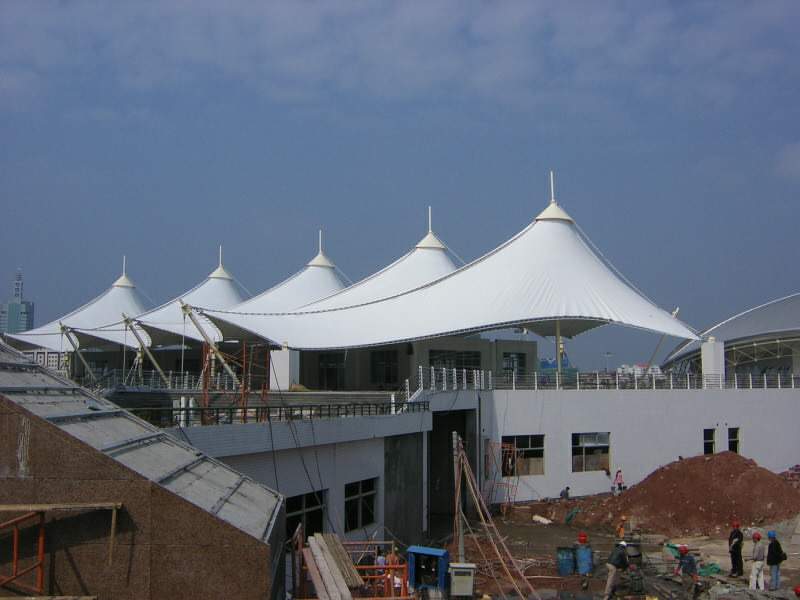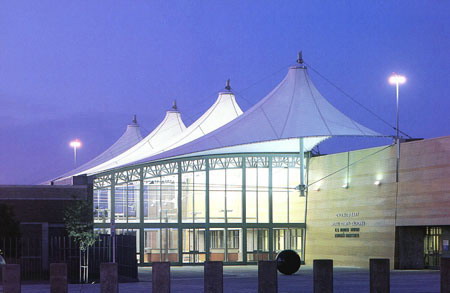Contact HOFO
Mobile:+86 15012841936
WhatsApp:+8615012841936
WeChat:15012841936
Skype:+8615012841936
E-mail:hofosales@hotmail.com
Address: Room 412, Siyufu, Number 10, Nanxin Road, Longgang District, Shenzhen, China
Tensile Structures as the Most Advanced Lightweight Structures
Tensile Structures
Tensile structures represent the perfect union of art and engineering. They represent spatial structures of a minimalist character. Their form is curved but neat, and the details are either completely eliminated or significantly reduced. These spatial structures are exceptionally lightweight, both in terms of their actual weight and visual manifestation. The shape of a tensile structure obtains another visual level when shadows appear on it, since the play of light and shadows on a curved surface has a dramatic effect. Even though the form of the tensile structure appears to be its greatest advantage in an aesthetic sense, it does not require any forced structural solutions, but is itself the only necessary element for the stability of the structure. Thus the form of a tensile structure becomes the most important characteristic both in an architectural and structural sense.

Tensile structures in their most basic form have been in use since early history. Research has indicated that the first tents dated back from approximately 20 000 BC. Quite similar tents are being used to this very day. Their basic function, to protect people from any inclement weather conditions, has remained unchanged, but the improvements in the sense of using other structural materials are obvious. Modern tensile structures usually differ from tents based on their size, degree of complexity, form and structural material, but their purpose is also to protect a great number of people from the sun, rain, wind and snow. In addition to function, tensile structures also inherited their shape from tents, but it had to be modified in order to meet structural requirements. One of the best characteristics of tents is their ability to be put up and taken down very quickly, which enables them to be relocated easily form one place to another. However, modern tensile structures in the greatest number of cases have shed this characteristic, and are not produced as transferrable, even though they are completely prefabricated. Nevertheless, they are still exceptionally lightweight, and as a result offer many advantages in terms of erecting and transport.
Modern tensile structures were first designed by the Russian engineer Vladimir Shu-khov. In 1896 he designed and built two halls with a tensile structural system for the All-Russian Industrial and Art Exhibition in Nizhny Novgorod. However, in the next 50 years no significant objects using the tensile structure were built. It was not until the middle of the 20th century that engineer Otto Frei realized the possibilities that such a structural system had and began developing it. Frei is the most deserving for the promotion of tensile structures; his buildings still stand to this very day as architectural landmarks.
Tensile systems can be divided into two sub-systems, cable net and membrane structures. Cable net structures consist of a network of interconnected bearing cables and a cover which can consist of various different, usually transparent materials. The most famous objects built using this subsystem are the German pavilion built for the World Fair Exhibition in Montreal in 1967, and the stadium in Munich built for the Olympic Games in 1972. Membrane structures were designed as a result of the improvement in cable net structures and today have completely replaced them in practice due to their superior characteristics. In the case of membrane structures, there is a structural element which unites a bearing and covering role. This element is referred to as a membrane and the entire sub-system was actually named after it.
Tensile structures differ in many respects from traditional structural systems. Along with pneumatic structures, they have the smallest self-weight, which is several times smaller even compared to concrete shells. The weight of the membrane of tensile structures is approximately 1 kg/m2. This is achieved by the membrane being only 1 mm thick. Considering the fact that with such a small weight they cannot significantly resist any external load, other forms of stabilization were developed. Due to its small thickness, the tensile structure cannot withstand pressure. That is why tensile structures are stabilized through tensile prestress forces. In order for the structure to remain stable, it always needs to be tensioned in all its points. The material which is used to design membranes possesses special characteristics and will be processed in more detail in the section Materials of tensile structures. Another characteristic of tensile structures is their double curvature. In order for them to be stable, they have to have to be doubly curved with a negative Gaussian curvature. In addition to it being necessary for achieving the stability of the structure, this form significantly contributes to the attractiveness of the tensile structure.
Tensile structures are usually used to cover sports fields and public areas, covering large areas using a minimum amount of material. Their advantages are two-fold. Esthetically, they are very attractive as they come in unusual curved forms, and allow the light to come in. Construction wise, tensile structures have an advantage over other structural systems because of their lightweight nature, which is a result of the fact that in the structure there are no moments of bending and compression forces. For that reason tensile structures were used in many important objects over the world. However, they also have certain shortcomings which need to be taken into consideration in order for them to be used successfully. Their biggest drawback is their poor thermal resistance, which is a consequence of the thickness of the structure. In addition, these structures are very susceptible to great deformations under the influence of external load. What sets tensile structures apart from other structural systems are their structural materials, but also their design and construction process. As one of the most recent and most promising structural systems, tensile structures offer many possibilities for further research and improvement.
Excerpt from masterbuilder







